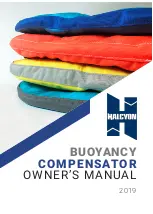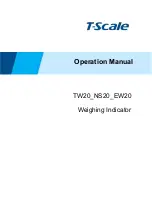
5
www.phywe.com, © All rights reserved
13621.00 / 3209
This measurement is based on the following principle:
The applied voltage is divided across a capacitive potential
divider
2
1
U
U
U
e
+
=
; with
2
2
1
1
U
C
U
C
⋅
=
⋅
2
1
2
)
1
(
U
C
C
U
e
⋅
+
=
⇒
,
On choosing C2 >> C1, then the following approximation is
valid:
2
1
2
)
1
(
U
C
C
U
e
⋅
+
=
⇒
,
To avoid damage to the instrument, C1 and C2 must be so
chosen that the voltage on amplifier input (
1
) does not
exceed 10 V, and that the maximum potential between
auxiliary input (
2
) and the electrometer amplifier earth does
not exceed 1 kV.
Caution!
Ensure that only correspondingly voltage resistant capacitors
are used!
Note:
The capacitance values given on capacitors are nominal
values and may deviate from the actual values. To obtain
exact measurement results, the actual capacitance must be
experimentally determined.
Recommended accessories:
Capacitor 0.1 µF, 250 V,
39105.18
in casing G1
Capacitor 10 nF, 250 V,
39105.14
in casing G1
Capacitor 1 nF, 100 V,
39105.10
in casing G1
Capacitor 100 pF, 100 V,
39105.04
in casing G1
Cable with 4 mm bunch plug
7.3 Measurement of small currents
Schematical experimental set-up:
The measurement is based on Ohm's law:
By measuring the decreasing voltage at a known resistance,
the current flowing through the resistor can be calculated.
I
=
U
/
R
=
U
e
/
R
=
U
a
/
R
This method is always then used, when small currents are to
be measured with which falsification would occur with a low
ohmic measuring instrument connected in parallel.
Recommended accessory:
Cable with 4 mm bunch plug
8 SETS OF EQUIPMENT FOR EXPERIMENTS
WITH THE ELECTROMETER AMPLIFIER:
Electrometer Amplifier, Set 1
07650.88
This set of equipment for experiments
on measuring charges comprises:
Faraday pail,
d
= 40 mm,
h
= 75 mm
13027.03
(small version)
Crocodile clips, bare, 10 pcs
07274.03
Connecting plugs, set of 2
07278.05
Connecting plug (for short-circuiting)
39170.00
4 mm/19 mm, white
Support rod with 4 mm hole
02036.01
(for earthing the experimenter)
Capacitor 1 nF, 100 V,
39105.10
in casing G1
Rod, polypropylene,
13027.07
d
= 8 mm,
l
= 175 mm
Acryl resin rod,
d
= 8 mm,
l
= 175 mm
13027.08
Electrometer Amplifier
13621.00
Electrometer Amplifier, Set 2
07651.88
This supplementary set of equipment for
experiments on measuring charges,
voltages and small currents comprises:
Film resistor 10 GW, 5%,
39104.77
in G1 casing
Film resistor 1 GW, 5%,
39104.76
in G1 casing
Film resistor 100 MW, 5%,
39104.75
in G1 casing
Film resistor 10 MW, 5%,
39104.58
in G1 casing
Capacitor 0.1 µF, 250 V,
39105.18
in G1 casing
Capacitor 10 nF, 250 V,
39105.14
in G1 casing
Capacitor 100 pF, 100 V,
39105.04
in G1 casing
Zinc electrode, 76 mm x 40 mm
(2x) 45214.00
9 NOTES ON THE GUARANTEE
We guarantee the instrument supplied by us for a period of
24 months within the EU, or for 12 months outside of the EU.
Excepted from the guarantee are damages that result from
Offset
Power
V
R
12V~
























